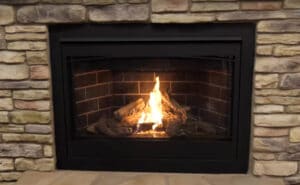
Sealing your fireplace keeps money in your pocket and cold air-conditioned air in your home. We created this quick how-to guide to get ahead of the financial drain and arm yourself so that in years to follow, you know what to do once fireplace season has come to a close.
To do this, you’ll need the following:
- Access to your favorite hardware store
- Fireplace doors or fireplace covers
- Flue and damper sealers
- Fireplace inserts
1. DIY Solutions
There are numerous solutions out there that you can find on the internet, or Youtube specifically, that will show you how to create some do-it-yourself insulation that you can apply to your fireplace to keep the cold air in. We do, however, want to caution that these aren’t always the best options. Using one of the other methods on our list will create longer-lasting and more reliable results.
2. Install Fireplace Doors or Covers
Fireplace doors and covers are applied to the opening of the fireplace. These help prevent and reduce heat loss and be either permanent or removable, depending on your preference. Adding one of these in now to prevent cold air from escaping could also pay off as added security during fireplace season, as you know that sparks won’t escape after you’ve closed the doors.
3. Install Flue or Damper Sealers
During fireplace season, you need to leave the damper open even while the fire is dying. This makes sure that your home is adequately ventilated. However, this becomes an issue in the warmed months when the flue or damper is left open, allowing cold air to escape up through the chimney. Some balloons can be fitted and inflated so that it creates an airtight seal. You’ll just have to make sure to remove them when it comes time to light a fire again!
4. Fireplace Inserts
Fireplace inserts are customized for your chimney. Call an expert who can come in and make the appropriate measurements so that your fireplace insert. These are cost-effective and custom-made, so you know you’re getting a reliable solution to your problem.
5. Get Your Chimney Inspected
The best way to properly seal your fireplace and to prevent wasting energy and money is to get your chimney inspected at least once a year. The inspector is qualified to check your chimney for anything that may be wrong with it and to make sure that it doesn’t have any leaks or breaks. This ensures that you can not only save energy during the summer months but that when you’re ready fora fire, you can do so safely.
FAQ
Can I enjoy my fireplace next season if I seal it up?
Of course! Most fireplace sealers are easily removable, so you can enjoy your fireplace the next time you want without the hassle of having to call someone to remove it for you.
What is the most cost-effective way to seal your fireplace?
DIY fireplace sealers are always a fantastic and cost-efficient option. However, they aren’t always the most reliable, so flue and damper sealers are a more efficient method.
Why do I need to seal a fireplace?
Sealing a fireplace prevents both a waste of money and your cool air! It also ensures that your fireplace doesn’t have any unwelcome visitors venture in through an unsealed flue or damper.
Conclusion

We would love to know what solution works best for you and to see any of your DIY projects! Leave them in the comments below, and if you know someone who needs to seal their fireplace, share this article with them.
